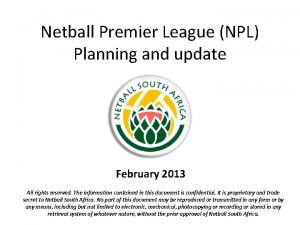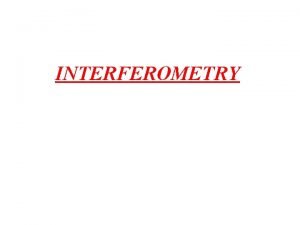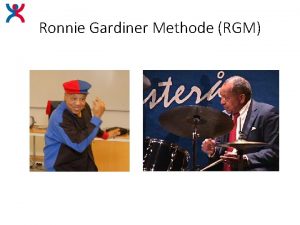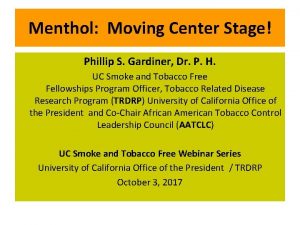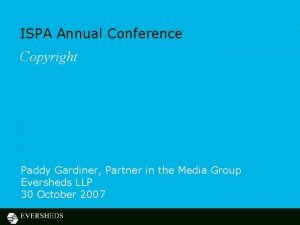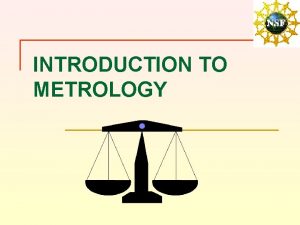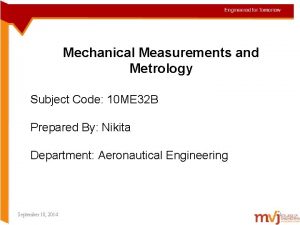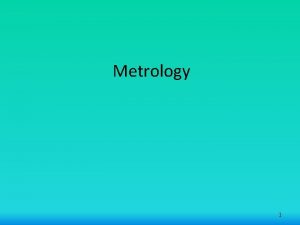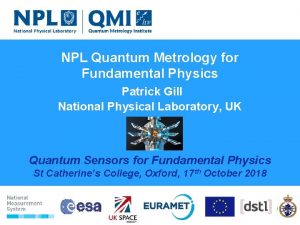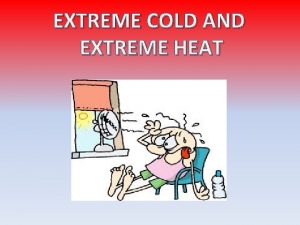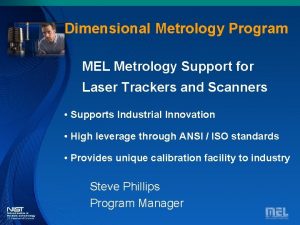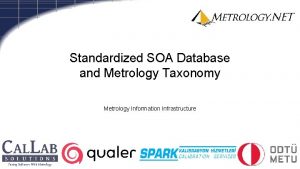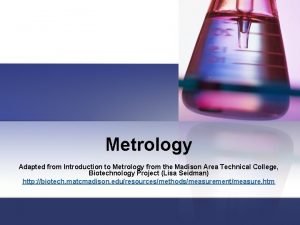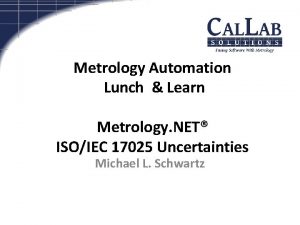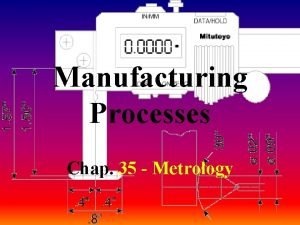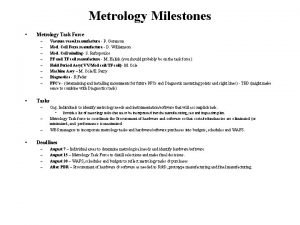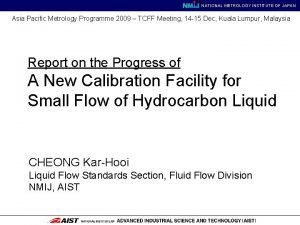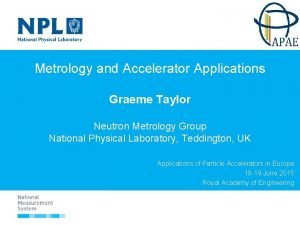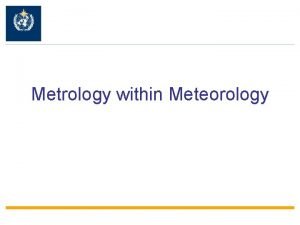Metrology for Extreme Environments Tom Gardiner NPL Andrea

















- Slides: 17

Metrology for Extreme Environments Tom Gardiner, NPL Andrea Merlone, INRIM EMPIR Environment Workshop 1 st December 2015, INRIM Welcome to the National Physical Laboratory

Contents § Background § Metrology challenges in the Arctic § Metrology challenges in the Upper Atmosphere

Euramet Strategic Research Agenda – Extreme Environments • Providing reliable data is vital to meet the challenge of climate change, and in many cases such measurements need to be made in extreme environments. • The Arctic and the Upper Atmosphere are two key examples of extreme environments where metrological support is needed. • The extreme ranges of variability of the key-quantities measured requiring higher accuracy than for other areas need dedicated calibration procedures and specific uncertainty evaluation. • The logistical difficulties in reaching, removing, handling instruments for calibration campaigns require self validating measurements and calibration devices operating in extreme environmental conditions

Why is the Artic important ? § Effects of environmental change often seen first / amplified in the Arctic, and the Arctic is a significant potential source of positive feedback to climate change. § A large number of EU member states have territorial, scientific and commercial interests in the Arctic. § Environmental monitoring in the Artic is therefore vital to Europe since it influences climate change and adaption, food supplies (fishing), shipping, energy security (oil and gas), and biodiversity (terrestrial and aquatic). § A unique multi-organisational, multi-disciplinary facility exists at Ny Ålesund where many EU counties participate in Polar research. Much of this research is currently done without comparability and common traceability.

Break out session at Arctic Circle 2015

Why is metrology research needed in the Arctic ? § § The extreme ranges of variability of the key-quantities measured requiring higher accuracy than for other areas need dedicated calibration procedures and specific uncertainty evaluation, not available by usual calibration services. The logistical difficulties in reaching, removing, handling instruments for calibration require self validating measurement and calibration devices operating in arctic-based research stations. Unique common calibration procedures, improving the comparability of the instruments response across research groups. An active collaboration between metrologists and operators in defining calibration procedures, and testing and calibrating instrumentation.

Why is metrology research needed in the Arctic ? § § A centralised metrological infrastructure to benefit all researchers operating in the area, with an agreed common implementation plan. Time, funds and risks reduced in shipping instruments to national calibration services. Direct traceability to primary standards of the System of Units, arising from the involvement of National Institutes of Metrology , reduces calibration uncertainty. Improved comparability of data in space and time, among different systems and different research groups and stations ITS-90 fixed points.

Upper Atmospheric Requirements § § The upper atmosphere – the atmosphere above the boundary layer – is the most important region for climate research and atmospheric science. The composition and dynamics of the upper atmosphere determine the energy distribution in global atmosphere which in turn drives the weather and climate systems, and the long-range transport of pollutants around the globe. It is one of the most challenging regions to make high quality traceable measurements. Global Climate Observing System (GCOS) Report 112 : “Shortcomings in the design and implementation of the current upper-air measurement network greatly limit the accuracy and detail of observations needed to specify how climate has varied and changed above the Earth’s surface. This deficit impacts our ability to accurately predict climate change, and hence has potentially serious consequences in areas of high relevance to society. . . ” This report also stresses the importance of traceability in upper atmospheric measurements. The need for metrological research and support in this area was highlighted at a recent joint BIPM-WMO workshop (June 2015).

Water vapour trends in the troposphere? e. g. : Lindenberg 8 km (0: 00 UT)

Water vapour trends in the troposphere? e. g. : Lindenberg 8 km (0: 00 UT) Freiberg RKS-2 RKS-5 MARZ RS 80 RS 92

Reference Measurements in the Upper Atmosphere · GCOS Reference Upper Air Network · Network for ground-based reference observations for climate in the free atmosphere in the frame of the Global Climate Observing System, linked to WMO and UNEP. · Currently 16 stations, envisaged to be a network of 30 -40 sites across the globe · See www. gruan. org for more detail

GRUAN goals · Provide long-term high-quality upperair climate records · Constrain and calibrate data from more spatially-comprehensive global observing systems (including satellites and current operational radiosonde network) · Fully characterize the properties of the atmospheric column · Characterize observational uncertainties, with traceability to SI units or accepted standards · Comprehensive metadata collection and documentation · Validate observations through deliberate measurement redundancy Multiple instrument types all providing measurements of the same geophysical parameters.

Uncertainty example: Daytime temperature Vaisala RS 92 Sources of measurement uncertainty (in order of importance): · Sensor orientation · Unknown radiation field · Lab measurements of the radiative heating · Ventilation · Ground check · Calibration · Time lag

Comparing atmospheric measurements § A crucial aspect of upper air measurements is that the results are almost invariably integrated with or compared to other data sets (e. g. assimilation into meteorological forecasts, satellite validation or integration into atmospheric models). § Co-location / co-incidence: Natural variability makes comparison of atmospheric measurement particularly challenging. Need to consider the variability in time and space ( ) when comparing one measurement (m 1 with uncertainty u 1) against a second measurement or model (m 2 with uncertainty u 2) : § In addition, it is necessary to identify any common elements of the measurements or models, e. g. the underlying spectroscopy, that could lead to correlated uncertainties in the comparison/combination of data

Comparing atmospheric measurements § § § Multiple instrument types all providing measurements of the same geophysical parameters. Example for regular water vapour/humidity measurements : - Operational sondes (in-situ balloon-borne capacitance sensors) - Research sondes (in-situ balloon-borne frost point hygrometers and laser absorption sensors) - Raman lidar (remote sensing vertical profile measurements, usually at night) - Microwave radiometer (remote sensing total column measurement with some profile information) - Solar pointing FTIR (remote sensing total column measurement with some profile information, day-time only) - GNSS (remote sensing total column measurement from GPS satellite signals). Need to establish comparability between these methods, addressing the differences between the measurement techniques, including temporal and spatial coverages and resolutions.

In Conclusion § There is an urgent need for metrology support and research in the environmental extremes of the Artic and Upper Atmosphere. § Need to combine the expertise achieved in the individual, traditional fields of metrology into new interdisciplinary and multidisciplinary strategies that can be applied in the field. § European NMI community ideally positioned to meet this challenge, building on the underpinning metrology developed in the Meteo. Met EMRP projects. § Outputs of research would have immediate impact on the wide range of stakeholders making and using measurements in these areas.

Questions ?
 Extreme medium shot
Extreme medium shot Npl directive
Npl directive Npl netball
Npl netball Npl flatness interferometer
Npl flatness interferometer Npl certificate in educational leadership
Npl certificate in educational leadership Objectives of an employment contract
Objectives of an employment contract Ronnie gardiner methode
Ronnie gardiner methode Stone fox project ideas
Stone fox project ideas John gardiner farm
John gardiner farm Phillip gardiner tobacco
Phillip gardiner tobacco Norkshire
Norkshire Paddy gardiner
Paddy gardiner Nikki gardiner
Nikki gardiner Ataf ligament
Ataf ligament Symbolism in the devil and tom walker
Symbolism in the devil and tom walker Tom tom go 910
Tom tom go 910 Introduction to metrology
Introduction to metrology Metrology and measurements subject code
Metrology and measurements subject code


